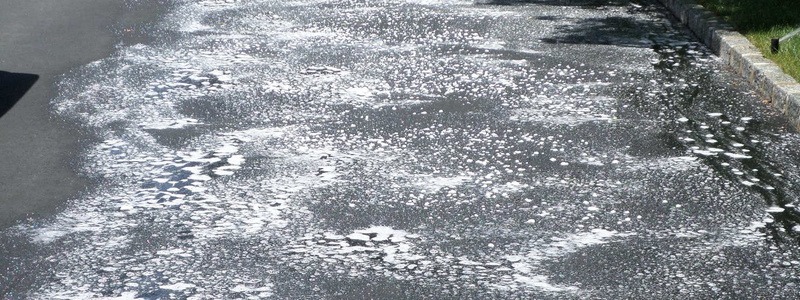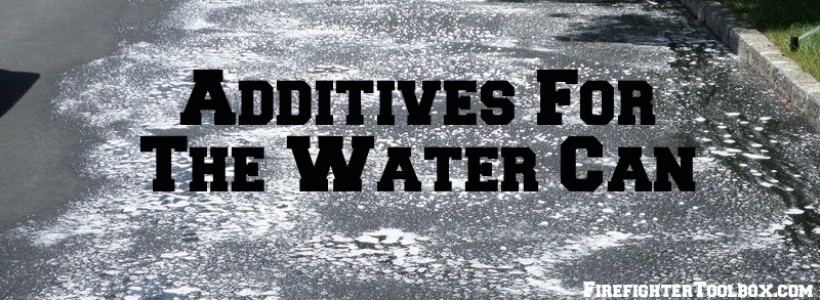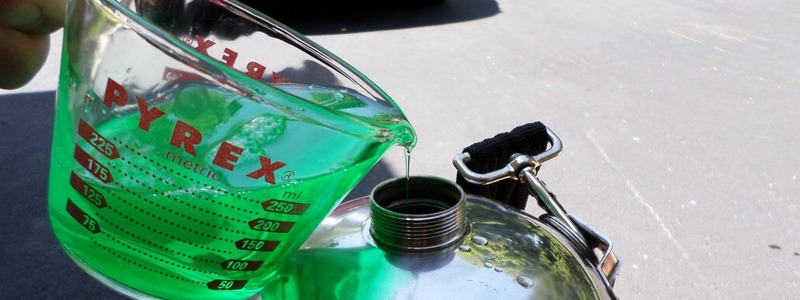Additives For The Water Can
Recently, we have taken a rather in depth look at the water extinguisher. The comments have been amazing; thank you all so much for taking the time to not only read but to comment as well. One of the most common comments on the site as well as on social media was the use of additives in the can. Let’s take a look…
#1 – Dish Soap
There has been a long standing discussion about the use of ordinary dish soap and fire extinguishment. Some debate that it is actually just as good as Class “A” foam. Actually it is not: dish soap is merely a wetting agent and will not give you the blanketing effect that foam does.
If you really want to stir the pot, get into the debate over which brand of dish soap actually works better! Instead of endless discussions I have a rather novel idea: why don’t we go out and actually test it! The wonderful thing about a water can is you can use it, charge it, and use it again. Try it for yourself and see which one is better (if there is actually any difference) and more cost effective in your opinion.
In my opinion, adding anywhere from 6-8 ounces, which is roughly one cup, of ordinary dish soap works fine. (You really do not have to be accurate and you really do not need that much. Just give it a few good squirts.) The soap merely acts by helping to break the surface tension of the water allowing it to penetrate better.
The more soap you add the more bubbles you get. Unless you are looking to take a bubble bath, more bubbles do not necessarily equate to better fire extinguishment.
As far as brands? You can get a big bottle on sale at your local grocery store that will seemingly last you a long time. Instead of over thinking it, go get a bottle and play. Each has its own application; determine what is best for your purpose.

This picture was cropped quite a bit. The area actually covered was 50 feet by 10 feet, effectively giving you 500 square feet of coverage. This application would be great for a brush fire.
#2 – Class A Foam
This type of foam was developed back around 1984 with the intent to make fighting Class A fires more efficient. It allows a blanket to be laid down on the burning material and stay there, while plain water will tend to bead up and run off if the heat does not evaporate it. One of the benefits of this is that it allows the firefighter to extinguish far more fire using less water.
This is ideal in our case since we are talking about only having 2 1/2 gallons of water at the maximum in the extinguisher.
The National Institute of Standards and Technology states that water treated with Class A foam is 3 to 5 times more efficient at firefighting that plain water alone. When used in a water can at a ratio of about 6-8 ounces per 2 1/2 gallons of water it works well for a Class A fire. Another use: applying it along the edge of a brush fire to keep the fire from spreading before a hose line can be stretched.
#3 – AFFF
Aqueous Film Forming Foam is extremely useful in the control of hydrocarbon fires. In my district the two main areas where this type of additive would come in handy is for vehicle fires and oil burner emergencies.
In the case of a vehicle fire, the extinguisher could be used to control the fire while a foam line is being placed into operation. You might even find that the can will actually extinguish the fire before the line is ready.
If you are ever called for smoke in the basement, carbon monoxide alarm activation or an oil burner emergency, bringing the foam can is always a good choice. Many departments will opt for the dry chem; however, I am a fan of the foam can. Basically I can handle anything I might run into fire-wise — with the exception of electrical — with the foam.
Ten ounces of foam in the water can seems to work well.
One issue you may run into is the extinguisher may get “gummed” up if it goes unused for an extended period of time. I usually give mine a good shake once or twice a week. Is that the magic trick? I don’t know, but it does seem to work. I have never had a problems with mine.
You will notice that a commercially bought foam extinguisher will come with an aeration nozzle on it. They do work well; however, a regular nozzle will work as well. If you want to “MacGuyver” your own aeration nozzle, a piece of fine mesh window screen zip tied to the nozzle does break up the stream enough to add a decent amount of aeration.
There are many types of commercially available additives that can be mixed in the extinguisher as well. I have no experience with any of these and would be open to trying them; I just have not had the opportunity.
If you have any experience with any of these additives or any other modifications you have done to the can, please contact me or leave them in the comment section. I would welcome hearing your opinions.
Photos courtesy of Rob Fling
Read additional articles on the can here!
The 2-1/2 Gallon Water Extinguisher – Uses
Taking Care Of The Can – Part 1 – Recharging
Taking Care Of The Can – Part 2 – Inspection and Maintenance
Taking Care Of The Can – Part 3 – Carrying and Modifications
Additives For The Can








Great article Chief! Thanks for sharing your knowledge on an undervalued piece of equipment. Keep up the great work!
Great article, I just moved from California where on my days off I was a volunteer fire Captain for Speedway Fire & Rescue. We used FireAide 2000 additive in our 2.5 & 1.5 gallon water extinguishers, mixed at 6% to make an extremely effective AFFF extinguisher. It worked well on any vehicle fire that we had We used the commercially available aerating nozzles to put down a nice blanket of foam. We always used these vs dry chemical extinguishers because as we all know, dry chemical extinguishers do NOT prevent re-ignition.
Thanks for the comment Jeremy!
As a dealer for Novacool UEF (Universal Extinguishing Foam), I leave 2 oz. “quick charges” with fire departments to test out the product. Just 2 oz.s turns a 2.5 gallon water extinguisher into a very effective Class A-B foam extinguisher. I’ve had many departments tell me about their first responders showing up with their 2.5 gallon foam extinguishers who were able to extinguish the fire before anyone else showed up. 2.5 gallons, with the right additive, can do a lot!
I am Deputy Chief of a small department in upstate NY. We started using the small bottles of FireIce in our water cans. We have had great success in everything from rubbish fires to working car fires to even extinguishing working structure fires with it. As chiefs we all carry a water can loaded with water and 1 bottle of FireIce. We have been doing it for the last 2 years or so and are very impressed. We have had no issues with it gumming up the working parts. It is easy to use and puts out a lot of fire. It gels out and coats whatever you spray to help stop reignition. I highly recommend this product and it is commercially available. It is widely used in the western part of the country to protect homes during wild fires. We attended a local demonstration and were sold immediately. We have referred all our neighboring departments to try this product for themselves.